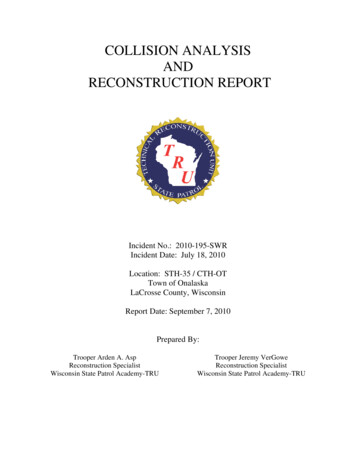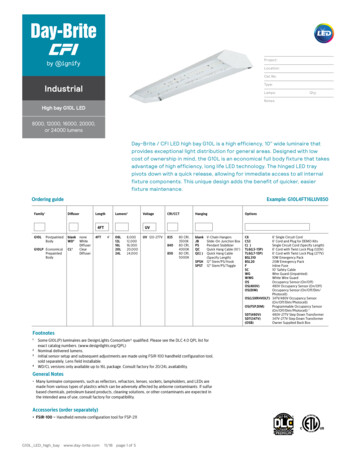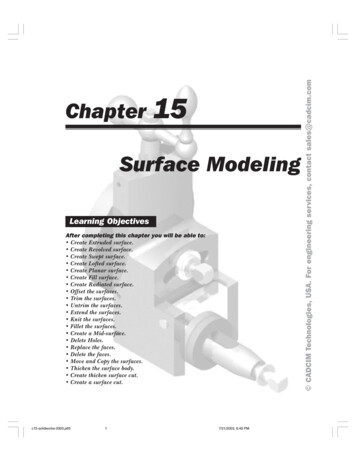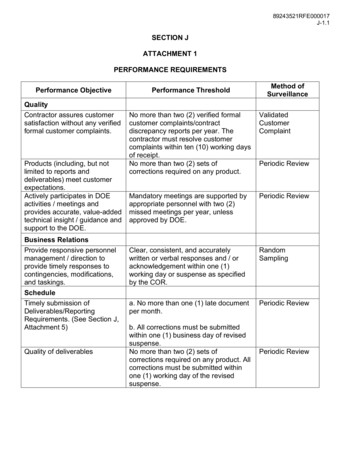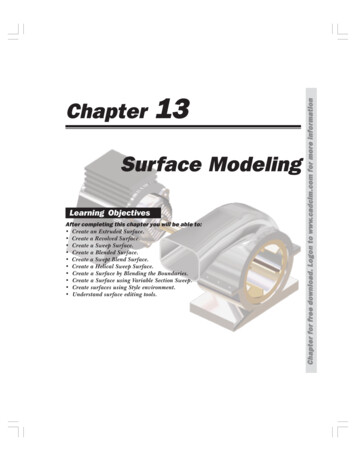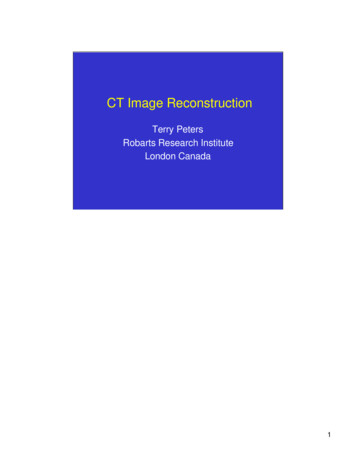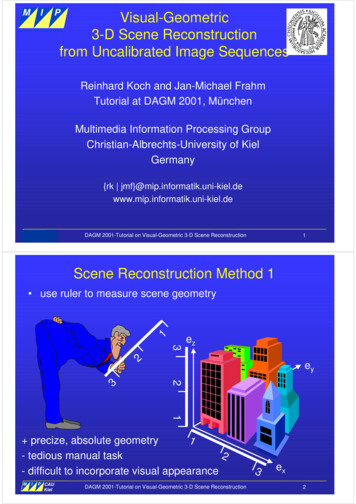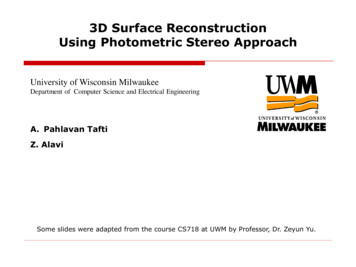
Transcription
3D Surface ReconstructionUsing Photometric Stereo ApproachUniversity of Wisconsin MilwaukeeDepartment of Computer Science and Electrical EngineeringA. Pahlavan TaftiZ. AlaviSome slides were adapted from the course CS718 at UWM by Professor, Dr. Zeyun Yu.
Outlines Problem Statement Motivation Taxonomy of the 3D surface Reconstruction Approaches Photometric Stereo Key Concepts Photometric Stereo and It’s Algorithm Our Proposed Contributions Dataset Implementation Experimental Results Conclusion and Future Works References
Problem Statement Thehuman vision structure obtains information about the real worldthrough planar images that are formed on the retina. Depth and 3D shape model of an object are perceived by the analysis ofthe stereo images captured from the left and right eyes. Themajor aim of computer vision is to provide human’s ability inanalyzing visual information and to enable computers to see like we do.This presentation focuses on one of the many challenges in computervision, the process of reconstructing a three-dimensional (3D) surfaceand the recovery of the depth information given a set of images underthe different light directions.
MotivationThe 3D reconstruction of a surface from images alone has many usefulapplications:1) In the entertainment industry, it has been widely applied in the processof movie making.2) Without the aid of 3D reconstruction, computer graphics artists wouldneed to spend many hours of CAD-modelling while often faced with theproblem of a lack of photo-realism when the objects are rendered.3) 3D reconstruction from images is also widely applied in the medicalindustry. It has been used to create models of a wide range of organs,as well as brains and cells.4) Other application areas include robot navigation, body motionmodelling, teleconferencing, remote surgery, object recognition, andVRML.(R. Hartley, 2004)
Taxonomy of the 3D Reconstruction Approaches3D Reconstruction MethodsActive MethodsThe light sources are specially controlled, as part ofthe strategy to arrive at the 3D information. Activelighting incorporates some form of temporal orspatial modulation of the illumination.Photometric Stereo is an Active approach to 3Dsurface reconstruction.Passive MethodsThe light is not controlled or only with respect toimage quality. Typically passive techniques workwith whichever reasonable, ambient light available.Figure 1: 3D reconstruction methods.(Hansen, 2012)
Photometric Stereo Key Concepts(Contd.) Photometric Stereo is an approach to reconstruct a 3D surface from aseries of images of a diffuse object under different point light sources. The surface reflectance obeys Lambert’s law: Light is reflected by asurface equally in every direction. Photometric stereo recovers depth information from multiple imagesunder different lighting conditions. The Mathematics of Photometric Stereo Include:1) Vector Analysis.2) Advanced Calculus.3) Differential Equations.(Woodham, 1980)(Ikeuchi, 1981)
Photometric Stereo Key ConceptsFigure 2: Applying Photometric Stereo.
Photometric Stereo and It’s AlgorithmInput: 2D Image, under differentlight sources.(Woodham, 1980)(Ikeuchi, 1981)(Hayakawa, 1994)(Longuet, 1981)Determine Light Direction1Determine Surface Normal2Determine Albedo3Determine Depth4Output: 3D Image.Figure 3: Block Diagram for Photometric Stereo Algorithm.(Contd.)
Photometric Stereo and It’s AlgorithmStep 1(Contd.)Determine Light DirectionBy changing the location of light and using a chrome sample as our case studyin the same location as all the other objects, we can get the location of thelight source.OutcomeLight Vector.Algorithm1- Compute Centroid and Radius of our case study.2- Compute center of reflected light on the case study.3- The normal, N, at that point in the direction of the lineextending to the Centroid. Viewing angle X has a constantdirection for all pixels.4- Light direction L 2*(N*X)*N-XNotesSome preprocessing steps may/must be needed before this step.Table 1: Step(1) Determine Light Direction; Algorithm and Outcome.(Woodham, 1980)(Ikeuchi, 1981)(Hayakawa, 1994)(Longuet, 1981)
Photometric Stereo and It’s AlgorithmStep 2(Contd.)Determine Surface NormalOnce we know the light directions, we can recover the normals at each pixel.OutcomeSurface Normal Vector.Algorithm1- For Lambertian surfaces, intensity at any point on the surfacecan be given as I KdLnT, where I is pixel intensity, Kd is albedo,L is the reflected light direction (a unit vector), and n is a unitsurface normal.2- I L(KdnT) , put unknowns together.3- In order to determine n, we need at least three light sourceswhich are not in the same plane. We can solve for the productg Kdn by solving a linear least squares problem.4- Once we have the vector g Kdn , the length of the vector is Kdand the normalized direction gives n.NotesAn objective function definition is needed in this step.Table 2: Step(2) Determine Surface Normal; Algorithm and Outcome.
Photometric Stereo and It’s AlgorithmStep 3(Contd.)Determine AlbedoAlbedo step solves the parameter K for each pixel. Since we have alreadycomputed Normals for each pixel, using the following equations we can get K.Where J Ln in previous equations.OutcomeAlgorithmAlbedo per light channel.1)2)3)NotesObjective function and differentiation with respect to Kd is neededin this step.Table 3: Step(3) Determine Albedo; Algorithm and Outcome.
Photometric Stereo and It’s AlgorithmStep 4Determine DepthFor each pixel, we have the following equations.OutcomeDepth for each pixelAlgorithmNotesGroup all the equations for every pixels, we can solve the depth Zfor every pixel.Table 4: Step(4) Determine Pixel Depth; Algorithm and Outcome.(Woodham, 1980)(Ikeuchi, 1981)(Hayakawa, 1994)(Longuet, 1981)
Our Proposed Contributions1) General implementation of Photometric Stereo algorithm with Matlab.It’s already done.Matlab Implementation including the source code exists html2) Exploring a way to reduce 3D reconstruction errors.We obtained some experimental results (Distance of the light sources and numberof images).3) Working on different depth and real sample.We have faced with lack of real data.
DatasetWe used OpenGL for creating synthetic image (Sphere), under differentlight directions.-0.4, -0.4, 0.7-0.03, 0.17, 0.980.31, 0.51, 0810.11, 0.43, 0.89-0.21, 0.04, 0.99
ImplementationMatlab is used to develop the algorithm and approach.Main.mIt contains light directions and parameter initialization.PS.mIt sets some parameters and callsAlbedos.m and Depth.m respectively.Loadimages.mLoading synthetic images from our Dataset.Normals.mCreating normal map.Albedos.mCreating albedo map.Depth.mEstimating depth and surface reconstruction.Normals.m,Matlab Implementation including the source code exists html
Experimental Results (Contd.)1. Four different light sources (Close to the object)2. Six different light sources (Close to the object)3. Four different light sources (Far from the object)4. Six different light sources (Far from the object)5. Normal map comparison6. 3D model comparison
Experimental Results (Contd.)1. Four different light sources (Close to the object)Dataset-0.4, -0.4, 0.7-0.03, 0.17, 0.980.31, 0.51, 0810.11, 0.43, 0.89
Experimental Results (Contd.)1. Four different light sources (Close to the object)Normal and AlbedoNormal mapAlbedo map
Experimental Results (Contd.)1. Four different light sources (Close to the object)3D ModelView 1View 2View 3 View 3
Experimental Results (Contd.)2. Six different light sources (Close to the object)Dataset-0.4, -0.4, 0.7-0.03, 0.17, 0.980.31, 0.51, 0810.11, 0.43, 0.89-0.21, 0.04, 0.990.17, 0.45, 0.79
Experimental Results (Contd.)2. Six different light sources (Close to the object)Normal and AlbedoNormal mapAlbedo map
Experimental Results (Contd.)2. Six different light sources (Close to the object)3D ModelView 1View 2View 3
Experimental Results (Contd.)3. Four different light sources (Far from the object)Dataset20.00, 10.00, 12.00 -15.00, 32.00, 277.00, -1.00, 9.00 -9.00, -8.00, 17.00
Experimental Results (Contd.)3. Four different light sources (Far from the object)Normal and AlbedoNormal mapAlbedo map
Experimental Results (Contd.)3. Four different light sources (Far from the object)3D ModelView 1View 2View 3
Experimental Results (Contd.)4. Six different light sources (Far from the object)Dataset20.00, 10.00, 12.00-15.00, 32.00, 277.00, -1.00, 9.00-9.00, -8.00, 17.008.00, 12.00, 26.002.00, 3.00, 5.00
Experimental Results (Contd.)4. Six different light sources (Far from the object)Normal and AlbedoNormal mapAlbedo map
Experimental Results (Contd.)4. Six different light sources (Far from the object)3D ModelView 1View 2View 3
Experimental Results (Contd.)5. Normal map comparisonNormal map4 light sources(Close )Normal map6 light sources(Close )Normal map4 light sources(Far)Normal map6 light sources(Far)
Experimental Results6. 3D model comparison3D model4 light sources(Close )3D model6 light sources(Close )3D model4 light sources(Far)3D model6 light sources(Far)
Conclusion and Future Works Distant light sources and larger number of images under differentlight directions, could result in better results. We will investigate on error reduction and also creating pointclouds from the depth map as our future works.
References[1] J. Woodham. Photometric method for determining surface orientationfrom multiple images. Optical Engineerings 19, I, 139-144, 1980.[2] R. Hartley and A. Zisserman. Multiple View Geometry in Computer Vision.Cambridge University Press, ISBN: 0521540518, 2004.[3] K. Ikeuchi. Determining surface orientation of specular surfaces by usingthe photometric stereo method. IEEE Trans, Pattern Anal, Mach, Intell. PAMI3, 661-669, 1981.[4] H. Hayakawa. Photometric stereo under a light source with arbitarymotion. Journal of the Optical Society of America, 1994.[5] M. Hansen. 3D face recognition using photometric stereo. PhD Thesis,University of the West of England, 2012.
References[6] H. Longuet-Higgins. A computer algorithm for reconstructing a scenefrom two projections. Nature, vol. 293, no. 10, pp. 133–135, 1981.[7] J. Lebiedzik. An automatic topographical surface reconstruction in theSEM. Scanning, Vol. 2, pp. 230-237, 1979.[8] L. Reimer. Scanning Electron Microscopy: Physical of Image Formationand Microanalysis. 2nd Edition. Springer, pp. 146-156, 2008.[9] J. Paluszynski and W. Slowko. Surface Reconstruction with thephotometric method in SEM. Vacuum Vol. 78, pp 533-537, 2005.
Thanks
Photometric Stereo Key Concepts (Contd.) Photometric Stereo is an approach to reconstruct a 3D surface from a series of images of a diffuse object under different point light sources. The surface reflectance obeys Lambert's law: Light is reflected by a surface equally in every direction. Photometric stereo recovers depth information from multiple images



